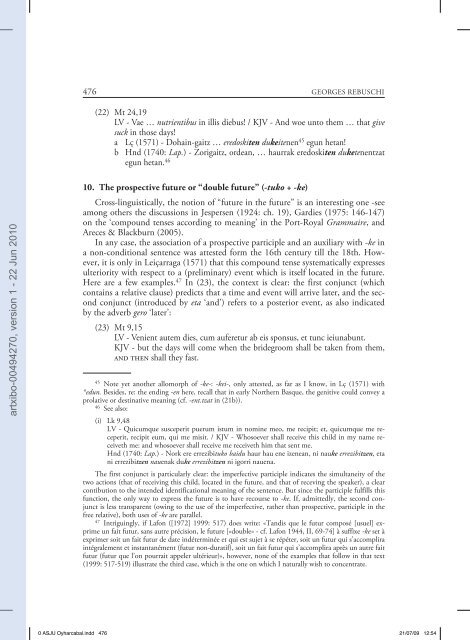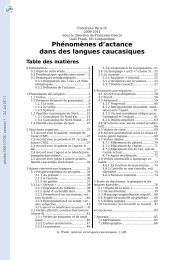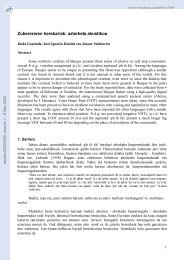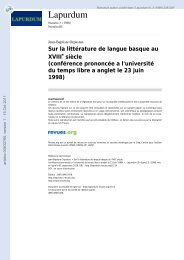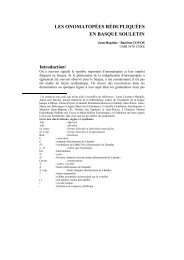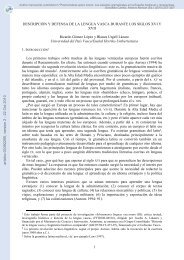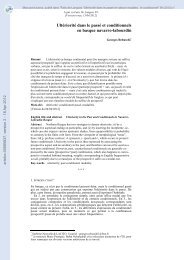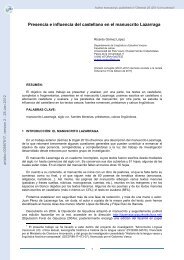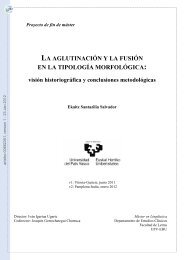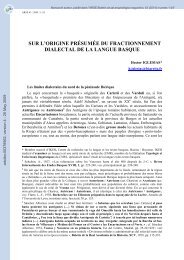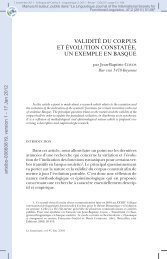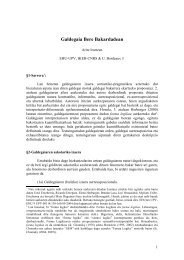On the polysemy of the suffike-ke in the history of Northern Basque
On the polysemy of the suffike-ke in the history of Northern Basque
On the polysemy of the suffike-ke in the history of Northern Basque
Create successful ePaper yourself
Turn your PDF publications into a flip-book with our unique Google optimized e-Paper software.
artxibo-00494270, version 1 - 22 Jun 2010<br />
476 GEORGES REBUSCHI<br />
(22) Mt 24,19<br />
LV - Vae … nutrientibus <strong>in</strong> illis diebus! / KJV - And woe unto <strong>the</strong>m … that give<br />
suck <strong>in</strong> those days!<br />
a Lç (1571) - Doha<strong>in</strong>-gaitz … eredoskiten du<strong>ke</strong>itenen 45 egun hetan!<br />
b Hnd (1740: Lap.) - Zorigaitz, ordean, … haurrak eredoskiten du<strong>ke</strong>tenentzat<br />
egun hetan. 46<br />
10. The prospective future or “double future” (-tuko + -<strong>ke</strong>)<br />
Cross-l<strong>in</strong>guistically, <strong>the</strong> notion <strong>of</strong> “future <strong>in</strong> <strong>the</strong> future” is an <strong>in</strong>terest<strong>in</strong>g one -see<br />
among o<strong>the</strong>rs <strong>the</strong> discussions <strong>in</strong> Jespersen (1924: ch. 19), Gardies (1975: 146-147)<br />
on <strong>the</strong> ‘compound tenses accord<strong>in</strong>g to mean<strong>in</strong>g’ <strong>in</strong> <strong>the</strong> Port-Royal Grammaire, and<br />
Areces & Blackburn (2005).<br />
In any case, <strong>the</strong> association <strong>of</strong> a prospective participle and an auxiliary with -<strong>ke</strong> <strong>in</strong><br />
a non-conditional sentence was attested form <strong>the</strong> 16th century till <strong>the</strong> 18th. However,<br />
it is only <strong>in</strong> Leiçarraga (1571) that this compound tense systematically expresses<br />
ulteriority with respect to a (prelim<strong>in</strong>ary) event which is itself located <strong>in</strong> <strong>the</strong> future.<br />
Here are a few examples. 47 In (23), <strong>the</strong> context is clear: <strong>the</strong> first conjunct (which<br />
conta<strong>in</strong>s a relative clause) predicts that a time and event will arrive later, and <strong>the</strong> second<br />
conjunct (<strong>in</strong>troduced by eta ‘and’) refers to a posterior event, as also <strong>in</strong>dicated<br />
by <strong>the</strong> adverb gero ‘later’:<br />
(23) Mt 9,15<br />
LV - Venient autem dies, cum auferetur ab eis sponsus, et tunc ieiunabunt.<br />
KJV - but <strong>the</strong> days will come when <strong>the</strong> bridegroom shall be ta<strong>ke</strong>n from <strong>the</strong>m,<br />
and <strong>the</strong>n shall <strong>the</strong>y fast.<br />
45 Note yet ano<strong>the</strong>r allomorph <strong>of</strong> -<strong>ke</strong>-: -<strong>ke</strong>i-, only attested, as far as I know, <strong>in</strong> Lç (1571) with<br />
°edun. Besides, re: <strong>the</strong> end<strong>in</strong>g -en here, recall that <strong>in</strong> early Nor<strong>the</strong>rn <strong>Basque</strong>, <strong>the</strong> genitive could convey a<br />
prolative or dest<strong>in</strong>ative mean<strong>in</strong>g (cf. -ent.tzat <strong>in</strong> (21b)).<br />
46 See also:<br />
(i) Lk 9,48<br />
LV - Quicumque susceperit puerum istum <strong>in</strong> nom<strong>in</strong>e meo, me recipit; et, quicumque me receperit,<br />
recipit eum, qui me misit. / KJV - Whosoever shall receive this child <strong>in</strong> my name receiveth<br />
me: and whosoever shall receive me receiveth him that sent me.<br />
Hnd (1740: Lap.) - Nork ere errezibituko baidu haur hau ene izenean, ni nau<strong>ke</strong> errezibitzen, eta<br />
ni errezibitzen nauenak du<strong>ke</strong> errezibitzen ni igorri nauena.<br />
The first conjunct is particularly clear: <strong>the</strong> imperfective participle <strong>in</strong>dicates <strong>the</strong> simultaneity <strong>of</strong> <strong>the</strong><br />
two actions (that <strong>of</strong> receiv<strong>in</strong>g this child, located <strong>in</strong> <strong>the</strong> future, and that <strong>of</strong> recev<strong>in</strong>g <strong>the</strong> spea<strong>ke</strong>r), a clear<br />
contibution to <strong>the</strong> <strong>in</strong>tended identificational mean<strong>in</strong>g <strong>of</strong> <strong>the</strong> sentence. But s<strong>in</strong>ce <strong>the</strong> participle fulfills this<br />
function, <strong>the</strong> only way to express <strong>the</strong> future is to have recourse to -<strong>ke</strong>. If, admittedly, <strong>the</strong> second conjunct<br />
is less transparent (ow<strong>in</strong>g to <strong>the</strong> use <strong>of</strong> <strong>the</strong> imperfective, ra<strong>the</strong>r than prospective, participle <strong>in</strong> <strong>the</strong><br />
free relative), both uses <strong>of</strong> -<strong>ke</strong> are parallel.<br />
47 Intrigu<strong>in</strong>gly, if Lafon ([1972] 1999: 517) does write: «Tandis que le futur composé [usuel] exprime<br />
un fait futur, sans autre précision, le future [«double» - cf. Lafon 1944, II, 69-74] à suffixe -<strong>ke</strong> set à<br />
exprimer soit un fait futur de date <strong>in</strong>déterm<strong>in</strong>ée et qui est sujet à se répéter, soit un futur qui s’accomplira<br />
<strong>in</strong>tégralement et <strong>in</strong>stantanément (futur non-duratif), soit un fait futur qui s’accomplira après un autre fait<br />
futur (futur que l’on pourrait appeler ultérieur)», however, none <strong>of</strong> <strong>the</strong> examples that follow <strong>in</strong> that text<br />
(1999: 517-519) illustrate <strong>the</strong> third case, which is <strong>the</strong> one on which I naturally wish to concentrate.<br />
0 ASJU Oyharcabal.<strong>in</strong>dd 476 21/07/09 12:54


